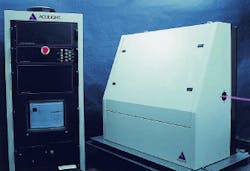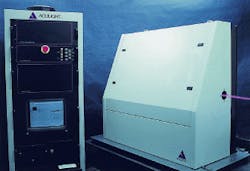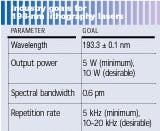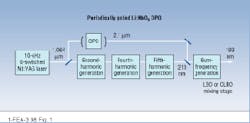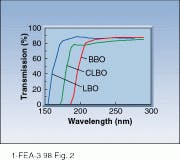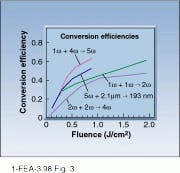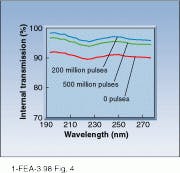Lithography offers market
Lithography offers market
for UV solid-state lasers
Roy D. Mead and Charles I. Miyake
The large and demanding microprocessor-fabrication market beckons to frequency-converted solid-state lasers that could be the source of UV radiation needed for next-generation chips.
As market demand for faster and more-capable microprocessors and memory chips grows, finer feature sizes are needed to pack more microprocessor capability or memory storage capacity onto a single chip. Volume production of chips with 0.35-µm feature sizes (including Intel`s Pentium processors and most 64-Mbit DRAM chips) is in full swing. Chip manufacturers are now installing equipment for production of devices with 0.25-µm feature sizes and are researching techniques for production of even smaller features.
The minimum feature size in a photolithographic process is proportional to the wavelength of light used to illuminate the pattern. The minimum feature size printable with a given wavelength of light depends upon a myriad of factors, including the lens numerical aperture, the contrast characteristics of the photoresist being patterned, and whether special optical resolution-enhancement techniques are used in transferring the pattern to the wafer. Currently, the minimum possible feature size is only slightly smaller than the wavelength of light performing the exposure, although with special techniques and extra care in control of processing parameters, feature sizes down to about 0.7 times the exposure wavelength are possible.
For the 0.35-µm features now being produced, the 365-nm (i-line) emission from a mercury lamp is used for exposure. At shorter wavelengths, where materials to build lenses corrected for chromatic aberration are limited, only laser sources can produce powerful radiation with bandwidths narrow enough to allow good imaging. For 0.25-µm features, the krypton fluoride (KrF) excimer laser at 248 nm is the light source of choice, and it will probably also be used in combination with resolution-enhancing techniques for features down to about 0.18 µm. For some 0.18-µm production and for smaller features, the industry expects to use argon fluoride (ArF) excimer lasers at 193 nm.
Recent rapid development of nonlinear optical techniques for the ultraviolet (UV) region show that solid-state alternatives to the ArF laser could be a superior choice, but the solid-state laser must meet certain stringent requirements (see table on p. 114). A tremendous investment in optical design and photoresist development has already been made to provide solutions working with 193-nm light, and the industry will not abandon this wavelength for the convenience of laser technologists. This eliminates from consideration the 213-nm fifth harmonic of the Nd:YAG laser and several other wavelengths readily produced by frequency-converted solid-state lasers.
Several watts of narrowband output are needed, posing a serious challenge to deep-ultraviolet wavelength conversion technology. Surprisingly, the excellent spatial coherence of converted solid-state lasers is a disadvantage for lithography; interference effects lead to speckle at the wafer, which disrupts the desired pattern being printed. Although current excimer lasers operate at a 1-kHz pulse-repetition rate, much-higher repetition rates are desirable to counteract the speckle by averaging many pulses. Higher repetition rates also permit superior control of the radiation dose. Finally, the laser must be astoundingly reliable and have low life-cycle costs (called costs of ownership in the industry). Mean time between failures should be in the many thousands of hours, with system lifetimes of several years. Typical costs for the excimer laser systems now in use are about $500,000 to purchase the laser, plus several tens of thousands of dollars per year for maintenance and laser gases.
Advances in technology now make possible a solid-state 193-nm laser with inherent characteristics desirable for lithography. Building excimer lasers with pulse rates >1 kHz is very difficult because the hot, disturbed gas must be cleared from the discharge region after each pulse. In contrast, solid-state lasers readily achieve repetition rates in the tens of kilohertz range. The solid-state laser typically can provide one-tenth the peak intensity compared to an excimer laser, reducing the peak power density on the stepper optics and extending their lifetime. Although dramatic improvements have been made in the fused silica and calcium fluoride used in wafer stepper optics, further lens lifetime improvements and associated life-cycle cost reductions would be desirable and could be achieved by use of the lower peak intensity from the solid-state laser.
Solid-state lasers potentially have longer lifetimes and lower operating costs than ArF excimer lasers. The excimer laser requires periodic replacement of the laser gas, replacement of the laser chamber and its windows, and replacement of the intracavity wavelength control optics. In comparison, some diode-pumped solid-state lasers and nonlinear optical wavelength converters have demonstrated operational lifetime capability of >10,000 hours.
Achievement of spectral linewidths of <0.1 pm for use with refractive lens systems is straightforward in solid-state laser systems, a significant advantage in wafer steppers with refractive optics. Excimer lasers typically provide a linewidth >0.8 pm with further linewidth reductions causing significant power loss. Infrared line-narrowing optics used in a solid-state laser have high reliability compared to the optics used in the excimer that are exposed to intense intracavity UV light.
Frequency conversion
It would be comparatively simple to achieve efficient conversion at reasonable average power by using hundreds of hertz repetition rate pulses with high peak power. Such an approach would avoid the difficulties presented by walk-off and diffraction in nonlinear optics, because with high peak power, large beam diameters can be used while maintaining the required peak power per unit area needed to drive nonlinear conversion. Unfortunately, development of such a lower-pulse-rate laser does not provide the full benefits of a >10,000-Hz pulse rate 193-nm laser.
Aculight has patented a technical approach for a 193-nm-emitting laser with 5-10 W of power (see Fig. 1 and photo on p. 113). This system is being developed under funding from the Air Force Wright Laboratory (Dayton, OH). This concept is based on generating the fifth harmonic of a 1064-nm Nd:YAG pump laser. The fifth harmonic is then frequency mixed with the output from a periodically poled lithium niobate (PPLN) optical parametric oscillator (OPO) to produce radiation near 193 nm.
This approach has a number of technical advantages. The very low threshold of the PPLN OPO requires a small fraction of the pump energy leaving most of the power for conversion to the fifth harmonic and subsequently to 193 nm. This performance means that the tunable part of the photolithography system now uses less than 20% of the pump energy, and nearly all of the 1064-nm pump energy can now be used to increase the 193-nm output. In contrast, low-pulse-energy OPOs constructed of bulk phase-matched nonlinear materials such as potassium titanyl phosphate (KTP) have low overall efficiency due to their relatively high pump-pulse-energy threshold.
The quasi-phase matching used in the PPLN OPO provides a high degree of flexibility in the infrared mixing wavelength, and this provides tunability in the generated 193-nm wavelength from the final mixing stage. By sum-frequency mixing 2.1 µm with the 213-nm harmonic, lithium triborate (LBO) or cesium lithium borate (CLBO) can be used in the final 193-nm stage, providing a material that has high optical transmission at 193 nm. Although the overall concept includes an OPO, this added complexity enables the 193-nm power to be scaled up, as all nonlinear crystals are used in wavelength regions where they have good transmission. The LBO is transmissive to 160 nm, and CLBO is transmissive to 180 nm (see Fig. 2). Both LBO and CLBO are acceptable for the final mixing stage, and their deep-UV transparency bodes well for handling substantial ultraviolet power. A recent study achieved 4 W of 213-nm output power by mixing the 1064-nm Nd:YAG fundamental with its fourth harmonic at 266 nm in CLBO.2
The primary technical hurdles that must be met relate to achieving efficient conversion for low-peak-power pulses, maintaining conversion at high average power in the nonlinear optical system, and achieving long life in the nonlinear optical system components. Perhaps the greatest challenge is providing output power on the order of 10 W at 193 nm. The combination of high power in the nonlinear optics and low-pulse-energy/ high-repetition-rate pulse format is especially demanding. The power goal must be achieved at a high repetition rate to minimize optical damage, facilitate speckle averaging, and, with good efficiency, to allow scaling to higher power.
Test results found that the nonlinear wavelength concept can provide good conversion efficiency even with small 1064-nm pulse energies. With only 15 mJ of 1064-nm energy, the beamline generated more than 0.6 mJ of 193-nm output (see Fig. 3). These tests demonstrate a 193-nm wavelength converter in which state-of-the-art nonlinear crystals are used--and they have high optical transmission for potential scaling to high output power. By using a low-threshold OPO, the tests also show that the required 1-µm pump laser power is within the current state of the art. These conversion-efficiency tests show that a 150-W, 10-kHz, 1064-nm laser should be able to generate 5 W of 193-nm output.
Stanford University`s Center for Nonlinear Materials (CENOM), in collaboration with Aculight, is conducting a project to characterize the two-photon nonlinear absorption characteristics of the nonlinear crystals. According to Roger Route of Stanford, an ultrafast laser system has been set up providing 200-fs to 1-ps pulses for two-photon characterization tests of ultraviolet nonlinear materials at 193 nm. There is also concern that the intense UV light will degrade the transmission of the nonlinear optical crystals.
In another collaborative effort, MIT Lincoln Laboratories has conducted lifetime testing on LBO crystals, as part of its Sematech-funded materials-testing program. An LBO crystal supplied by Aculight was exposed to millions of pulses of 193-nm light from an ArF excimer laser, while its optical transmission was monitored. Even after 500 million pulses, the exposed crystal`s ultra violet transmission was better than that of the unexposed crystal (see Fig. 4). Vladimir Liberman of MIT said, "On the basis of these tests, LBO looks better than excimer-grade fused silica," although it is not as damage resistant as calcium fluoride.
Metrology applications
Solid-state 193-nm lasers of only tens of milliwatts also have application in the semiconductor-processing industry. Optical diagnostic, testing, and alignment lasers at 193 nm are needed, especially with narrow bandwidth. Light Age Inc. (Somerset, NJ) has developed an all-solid-state 193-nm laser source for optical diagnostics and interferometry.3 An injection-seeded alexandrite oscillator is used to generate a narrowband pulse at 772 nm. Because no conventional nonlinear crystals, including beta-barium borate (BBO), can phase-match for direct doubling of the second harmonic of alexandrite at 386 nm, a three-step fourth-harmonic-generation scheme was developed. The final step sum-frequency-mixes the alexandrite third harmonic at 257 nm with the fundamental wavelength in BBO to generate 193-nm output.
Even though the BBO crystal has appreciable bulk absorption of 30% cm-1 at the final output wavelength, 30-40 mW of 193-nm output has been repeatedly obtained. Currently, the main limitation to higher power at 193 nm is the strong absorption experienced in the fourth-harmonic BBO crystal. With recent improvements in the quality of BBO and the use of long pulses from the alexandrite laser, crystal damage does not appear to be a critical problem at power levels of 30-40 mW. Improvements in BBO or new materials such as SBBO (strontium beryllium borate) would boost the power scaling of the approach, although the repetition rate of alexandrite lasers is limited.
Aculight has also developed a low-power narrowband 193-nm laser providing 30 mW of 193-nm output with a bandwidth of <0.1 pm based on a similar approach to the high-power concept depicted in Figure 1. The design has been optimized for wavelength stability and accuracy and for ease of operation for interferometric measurement applications. The final mixing stage uses LBO, which suffers essentially no ultraviolet damage, so the system can operate for long periods without maintenance. Operating with a nominal repetition rate of 60 Hz to synchronize with the framing rate of CCD cameras, the system provides complete computer control of wavelength over the 193.0- to 193.6-nm range.
Although low-power 193-nm solid-state lasers have been manufactured, developing a moderate-power solid-state laser to meet future lithography goals presents a significant technical challenge. Recent development results indicate that power scaling and lifetime may no longer be major obstacles. o
REFERENCES
1. R. D. Mead, C. E. Hamilton, and D. D. Lowenthal, "Solid-state lasers for 193-nm lithography," in Optical Microlithography X, Gene E. Fuller, ed., Proc. SPIE 3051, p. 882.
2. Y. K. Yap et al., "High-power all-solid-state ultraviolet laser by CLBO crystal," in Advanced Solid-State Lasers, Technical Digest (OSA,Washington, DC, 1997), p 152.
3. W-B. Yan et al., Conference on Lasers and Electro-Optics, paper CFF5, OSA Technical Digest Series 17, 485 (1997).
Prototype solid-state laser produces 193-nm output by frequency mixing fifth harmonic of Nd:YAG with infrared OPO; such a system demonstrates UV output with <0.05-nm bandwidth.
FIGURE 1. To produce 193-nm output, some of the 1064-nm output of a Q-switched Nd:YAG laser pumps a PPLN OPO; the fundamental is also converted to the fifth harmonic. Sum-frequency generation in LBO or CLBO mixes these to produce 193 nm.
FIGURE 2. Transmission curves show LBO cuts off at 160 nm, while CLBO cuts off at 180 nm, and BBO at 200 nm. The UV performance of LBO and CLBO makes either of them suitable for the final nonlinear process of Fig. 1.
FIGURE 3. The nonlinear processes governing the generation of 193-nm light are relatively efficient over a wide range of pulse energies. Curves are shown for second harmonic (green), fourth harmonic (blue-purple), fifth harmonic (light purple), and fifth mixed with the OPO (very purple). For 15 mJ of fundamental, the system produced 0.6 mJ of 193-nm output.
FIGURE 4. Long-term exposure of LBO to millions of excimer laser pulses results in little change to transmission properties over the UV region.
